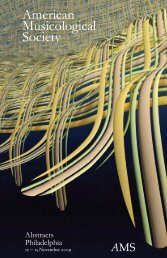Abstracts - American Musicological Society
Abstracts - American Musicological Society
Abstracts - American Musicological Society
Create successful ePaper yourself
Turn your PDF publications into a flip-book with our unique Google optimized e-Paper software.
18<br />
Friday morning<br />
equality (through a variety of irnitative procedures) '<br />
structural .oh"..n"" (especially through rnotivic<br />
constructlon), and attention to declarnatiott ^ ?ttd<br />
expressive gestures. These texturally clarifying<br />
features nay also be found in the Mass music of the<br />
period.<br />
TEXTS AND TEXTING IN THE<br />
EARLY CHANSONS OF GUILLAUUE DUFAY<br />
Graeme M. Boone , Harvard University<br />
In recent years, studies of fifteenth-century<br />
chansons have increasingly turned. to the poetic texts<br />
as a crucial element in their analysis. Nonetheless,<br />
no system has been found to explain the way composers<br />
set about putting the texts to music, a dilemma<br />
evidenced in the persistence of arnbiguities in text<br />
underlay. On the contrary, some recent trends point<br />
away from overall systems, focusing ratherupo. the<br />
conscious distinctness of the individual piece.<br />
This paper will outline a simpla rheory<br />
explains<br />
that<br />
Dufay's early text-setting p.o"!drr.=.<br />
Established by a strong consensus of sJurc. readings,<br />
the theory permits correction of errors not only in Ihe<br />
collected edition, but ultimately in the Lriginal<br />
sources thenselves, and provides tirereby a firm iasis<br />
for underlay in this repertory. Its impact on musical<br />
analysis is extensive; and when considered in<br />
perspective,<br />
Larger<br />
it appears as part of a remarkably unified<br />
French song technique ranging frorn the thirieenth<br />
the<br />
to<br />
sixteenth centur_ies. Flnally, the text-setting<br />
rules will be considered in relLtionship to middle<br />
French poetics in general, wherein it vrilI be seen that<br />
each serves to clarify the other in new and significant<br />
ways.<br />
ON THE TEXTING OF OBRECHT MASSES<br />
Barton Hudson, West Virginia Univers ity<br />
Munich, Universit6tsbibliothek Ms. 20 Art. Z3g<br />
contains Obrecht's Missa Fors seulement with a notation<br />
indicating Chat it was copied by Heinrich Glareanus and<br />
Peter Tschudi from a manuscript in the composer's own<br />
hand (ab exemplari eiusdem, i. e. Hobrechti, descripta) .<br />
S ince the Munich nanuscript pt gives every everv evidence evi denno of ^1<br />
hawing been carefully prepared, it should give a sood<br />
idea of rhe srare of rhe Mass when th;<br />
"o..1])<br />
: I : : :l::. I^t-': .': - .3j, ^o^i' "^t," " t^i: i n t e r e s t i s .";:" "<br />
distribution--some voices of some ^ sa.ri^-^<br />
--': ; rs^L : ; :<br />
underlaid, some prowided provided<br />
cornpletely .*uv,receI)<br />
onlv only .i;;-'^',:lt-t with<br />
limited to inciDi incipits. ts Tn In some ^+L^- other "ro" drru some<br />
mas-o-'<br />
shown stemmatically where where simil similar ar .-^.._l-"J-<br />
-""o I lt u<br />
nounts<br />
can be<br />
" of c"*t rnr"t










